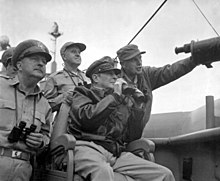USS Mount McKinley
Returning to the United States 12 February 1946, she sailed in the early summer for Bikini Atoll where she was flagship for Operation Crossroads, flying the flag of Admiral William H. P. Blandy, Joint Task Force One's commander during the atomic tests.
When the Chinese People's Volunteer Army entered the war and UN troops were pushed back to the Hungnam beachhead, Mount McKinley assisted in the evacuation.
On 7 June 1951, Mount McKinley sailed from Yokosuka and entered Mare Island Naval Shipyard 3 August for an extensive overhaul.
Mount McKinley sailed again, 27 October 1953, for her third tour of duty in the Korean War area, arriving at Yokosuka 16 November.
After arrival in San Diego 18 August, the remainder of the year was spent in local operations and a month-long training exercise off Hawaii in October.
In the spring of 1955, Mount McKinley served as flagship for Operation Wigwam, an underwater atomic bomb test in the central Pacific.
Mount McKinley was anchored in Portsmouth Navy Yard to provide command and control for parts of the 'Orange' opposition naval forces during Operation Strikeback.
Mount McKinley's third Mediterranean cruise from 20 February to 26 August 1959 was marked by seven amphibious exercises involving U.S. and NATO forces.
In February 1960, the ship sailed to Valparaíso, Chile, via the Panama Canal to provide communications support for President Eisenhower's good will visit to Latin America.
Upon completion of her yard period in the summer of 1961, Mount McKinley made her fifth deployment to the Mediterranean from September to February 1962, acting as flagship for several large scale amphibious exercises.
After refresher training and exercise "Quick Kick V", AGC 7 departed Norfolk 10 May, arriving San Diego 26 May via Panama Canal.
[clarification needed] She relieved its sister ship, USS Eldorado, at Subic Bay a week later, becoming flagship of the 7th Fleet, Amphibious Strike Force.
Taking station in the South China Sea, with other elements of Amphibious Group 1, Mount McKinley stood prepared for any contingency.
In early March and again in mid April, the flagship coordinated the landing of Marine reinforcements at Da Nang and Huế, South Vietnam.
Based there, the ship visited ports in Japan, Taiwan, Hong Kong, Vietnam, and Okinawa, acting as flagship of ComPhibGru 1.

